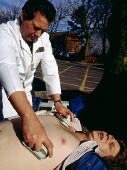
FRIDAY, March 22 (HealthDay News) — To improve the quality of lifesaving devices called automated external defibrillators, the U.S. Food and Drug Administration proposed Friday that the seven manufacturers of these devices be required to get agency approval for their products.
Automated external defibrillators (AEDs) are portable devices that deliver an electrical shock to the heart to try to restore normal heart rhythms during cardiac arrest. Although the FDA is not recalling AEDs, the agency said that it is concerned with the number of recalls and quality problems associated with them.
“[The] FDA is not questioning the clinical utility of AEDs,” Dr. William Maisel, chief scientist in FDA’s Center for Devices and Radiological Health, said during a press conference on Friday announcing the proposal.
“These devices are critically important and serve a very important public health need. The importance of early defibrillation for patients who are suffering from cardiac arrest is well-established,” he said.
Maisel added the FDA is not calling into question the safety or quality of AEDs currently in place around the country.
There are about 2.4 million such devices in public places throughout the United States, according to The New York Times.
“Today’s action does not require the removal or replacement of AEDs that are in distribution. Patients and the public should have confidence in these devices, and we encourage people to use them under the appropriate circumstances,” Maisel said.
Although there have been problems with AEDs, their lifesaving benefits outweigh the risk of making them unavailable, Maisel explained.
Dr. Moshe Gunsburg, director of cardiac arrhythmia service and co-chief of the division of cardiology at Brookdale University Hospital and Medical Center in Brooklyn, N.Y., supports the FDA proposal.
“Cardiac arrest is the leading cause of death in the United States. It claims over 250,000 lives a year,” he said.
Early defibrillation is the key to helping patients survive, Gunsburg said. Timing, however, is critical. If a patient is not defibrillated within four to six minutes, brain damage starts and the odds of survival diminish with each passing minute, which is why 90 percent of these patients don’t survive, he explained.
The best chance a patient has is an automated external defibrillator used quickly, which is why Gunsburg and others want AEDs to be as common as fire extinguishers so laypeople can use them when they see someone go into cardiac arrest. The FDA’s action will help ensure that these devices are in top shape when they are needed, he said.
But, there have been problems and failures with AEDs. Between 2005 and 2012 the FDA received about 45,000 reports of failure of these devices. In addition, there have been 88 recalls, Maisel said.
According to Maisel, it isn’t known whether failures of AEDs cause any deaths. That’s because when these devices are used, patients are in cardiac arrest and most die even when an AED is used and works well, he said.
However, machine defects may have contributed to patient deaths, the Times reported. For example, in one case, a nurse was attempting to attach a patient in cardiac arrest to a defibrillator when the device’s screen read “memory full.” In another case, a problem with a defibrillator’s software caused the device to read “equipment disabled” as it was being used on a patient. In both cases, the patient died, the newspaper said.
The actual number of AED failures is also not known, but, “it’s quite small,” Maisel said. The most common problems are random power shutdowns, erroneous error messages and failure of the components of the machine, he noted.
“Tens of thousands of adverse events is too many. We think 88 recalls are too many,” Maisel said.
“So, by calling for pre-market approval we can focus our attention on the types of problems that have been observed and our expectation is that we will observe an improvement in the reliability over time with these devices,” he said.
This action is being taken based on the recommendation of the FDA’s Circulatory System Devices Panel, which wants AEDs to be a Class III medical device requiring pre-market approval.
AEDs were on the market before the current approval process for Class III medical devices was updated, so they didn’t need pre-market approval. But given their problems they should now require approval, Maisel said.
In addition to the safety and effectiveness data, the application must include a review of a manufacturer’s quality systems and an inspection of its plant.
According to the FDA, after the device is approved, the manufacturer must submit any significant changes made to the device, as well as a yearly report on the device’s performance.
The public will have 90 days to comment on the FDA proposal. When the proposal becomes final, the process of getting all AEDs approved will take about two years, Maisel said.
More information
For more information on automated external defibrillators, visit the U.S. National Heart, Lung, and Blood Institute.

